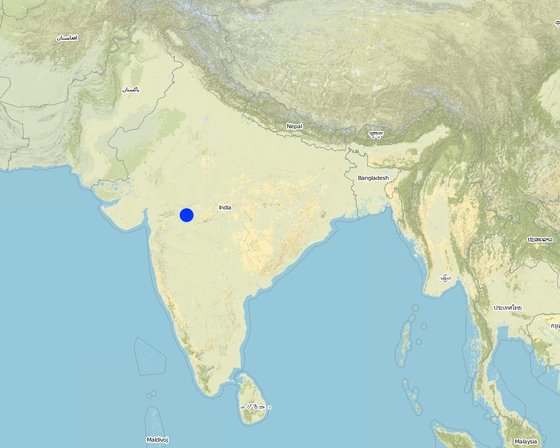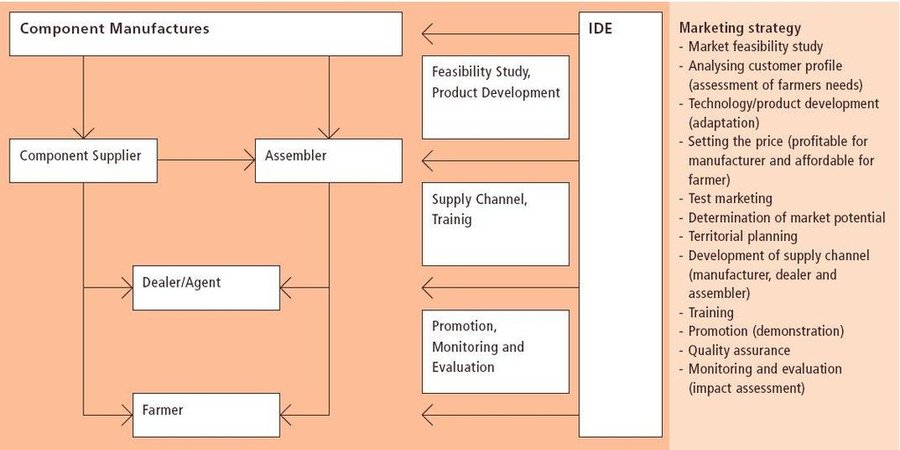Market support and branding for input quality (Krishak Bandhu)
(ອິນເດຍ)
ຄຳອະທິບາຍ
Market development and support through use of a brand name - Krishak Bandhu ('the farmer's friend') - to help ensure quality amongst manufacturers and suppliers of drip irrigation equipment.
Aims / objectives: Poor smallholder farmers are generally slow in adopting new technologies, especially when such decisions require relatively large initial investments which only yield returns over a long period of time. Even when subsidies are made available, the high transaction costs act as a hindrance. After more than three decades of promotion by government, and despite subsidies as high as 90%, conventional drip irrigation technology remains exclusively popular amongst 'gentlemen' (better-off) farmers in India. Since it was first introduced in the 1970s, the total area under drip irrigation expanded sluggishly from 1,500 ha in 1985 to 225,000 ha in 1998, which is tiny compared to an estimated national potential of 10.5 million hectares.
Methods: IDE, India (IDEI) is an NGO dedicated to troubleshooting such problems through a unique market development approach. IDEI promotes simple, affordable, appropriate and environmentally sound technologies for poor smallholder farmers through private marketing channels, under the brand name Krishak Bandhu. Donor resources are accessed by IDEI to stimulate markets by creating demand for such technologies and by ensuring an efficient supply chain for the equipment. The key to the IDEI approach lies in its adoption and application of commercial business principles as well as in its path of socio-economic development as a tool to sustainability of programmes. IDEI seeks to create a strong and continuing demand by motivating and nurturing an effective supply chain (including manufacturers, dealers and assemblers of micro irrigation equipment). In West Nimar, Madhya Pradesh (as in the whole of India) IDEI supports the marketing of cheap, good quality equipment for so-called 'Affordable Micro-Irrigation Technologies' (AMIT) such as pepsee (see associated technology). The promoted technology in this case is based on a farmer's innovation, which then was promoted and spread by IDEI.
Stages of implementation: IDEI has intervened in four major ways: (1) technically it has further developed the local innovation, pepsee, and come up with an improvement, aptly named 'Easy Drip'; (2) it has promoted small manufacturers of drip irrigation equipment and associated them with a brand name; (3) it has trained and supported private sector 'service providers' to assist farmers to install and adopt the systems; (4) on an ad hoc basis, IDEI commissions and supports studies on uptake and impact. Technologies promoted by IDEI provide returns on investment of at least 100% in one year which is crucial in explaining the success of pepsee. Within five years the projects supported by IDEI should become self-sustaining.
ສະຖານທີ່

ສະຖານທີ່: West Nimar, Madhya Pradesh, ອິນເດຍ
ການຄັດເລືອກພື້ນທີ່ ທີ່ອີງໃສ່ຂໍ້ມູນທາງພູມີສາດ
ວັນທີເລີ່ມຕົ້ນ: n.a.
ປີຂອງການສິ້ນສຸດ: n.a.
ປະເພດຂອງແນວທາງ
-
ພື້ນເມືອງ / ທ້ອງຖີ່ນ
-
ການລິເລີ່ມ ພາຍໃນປະເທດ ທີ່ຜ່ານມາ / ນະວັດຕະກໍາ
-
ພາຍໃຕ້ໂຄງການ / ແຜນງານ
ເປົ້າໝາຍຂອງແນວທາງ ແລະ ການປົກປັກຮັກສາສິ່ງແວດລ້ອມ
ເປົ້າໝາຍ / ຈຸດປະສົງຫຼັກໃນການຈັດຕັ້ງປະຕິບັດແນວທາງ
To bring affordable and appropriate water saving technologies to the rural poor through creating effective supply chains and developing markets, under a brand name associated with reliability.
The SLM Approach addressed the following problems: An underlying problem of increasing growing groundwater scarcity combined with the high investment costs of conventional drip irrigation equipment. On top of this is the reluctance of smallholder farmers to take government subsidies because of the high transaction costs (not easy to access; long delays and the reluctance to adopt new technologies). Local and cheap technological options are available, but quality and marketing channels are not assured.
ເງື່ອນໄຂທີ່ສະໜັບສະໜູນໃຫ້ການຈັດຕັ້ງປະຕິບັດເຕັກໂນໂລຢີ ບົນພື້ນຖານແນວທາງ
ເງື່ອນໄຂທີ່ເຊື່ອງຊ້ອນໃຫ້ການຈັດຕັ້ງປະຕິບັດເຕັກໂນໂລຢີ ບົນພື້ນຖານແນວທາງ
-
ສັງຄົມ / ວັດທະນະທໍາ / ມາດຕະຖານ ແລະ ຄຸນຄ່າທາງສາສະໜາ: Poor consumers are averse to risk and prefer to emulate the success of early-adopters. Hence, there's often a lag period between the introduction of the technology and its poverty impact.
Treatment through the SLM Approach: Every project should become self-sustaining within five years. IDEI therefore establishes the supply chain for manufacturing,IDEI therefore establishes the supply chain for manufacturing,IDEI therefore establishes the supply chain for manufacturing,distri
-
ມີຄວາມສາມາດ / ເຂັ້າເຖິງຊັບພະຍາກອນດ້ານການເງິນ ແລະ ການບໍລິການ: Private business decisions are based on profit margins and volumes and the often fragmented and cash-starved customers do not constitute an attractive market on their own.
Treatment through the SLM Approach: IDEI develops and nurtures the market for low-cost smallholder friendly technologies; thereby providing incentives to private businesses by encouraging growth in the size of the market.
-
ອື່ນໆ: economic: Poor consumers cannot make large investments and may even be willing to pay a higher per unit price as long as the one-time investment is lowered.
Treatment through the SLM Approach: IDEI identifies and develops appropriate technologies that have high poverty-alleviation potential, are produced locally; are environment friendly; and provide return on investment of at least 100% in one year.
ການມີສ່ວນຮ່ວມ ແລະ ບົດບາດຂອງພາກສ່ວນທີ່ກ່ຽວຂ້ອງທີ່ມີສ່ວນຮ່ວມ
ພາລະບົດບາດຂອງພາກສ່ວນທີ່ກ່ຽວຂ້ອງ ທີ່ມີສ່ວນຮ່ວມໃນການຈັດຕັ້ງປະຕິບັດແນວທາງ
| ແມ່ນໃຜ / ພາກສ່ວນໃດ ທີ່ເປັນເຈົ້າການ ໃນການຈັດຕັ້ງປະຕິບັດ ວິທີການ? |
ລະບຸ ພາກສ່ວນທີ່ກ່ຽວຂ້ອງ |
ພັນລະນາ ບົດບາດ ໜ້າທີ່ ຂອງພາກສ່ວນທີ່ກ່ຽວຂ້ອງ |
| ຜູ້ນໍາໃຊ້ດິນໃນທ້ອງຖິ່ນ / ຊຸມຊົນທ້ອງຖິ່ນ |
Smallholder farmers |
Traditionally, irrigation investments in particular, and farming in general, has been male-dominated. However, recent studies indicate that women play a critical role in the decision-making process, as these investments often compete with other household requirements. |
| ຜູ້ຊ່ຽວຊານ ການນຄຸ້ມຄອງ ທີ່ດິນແບບຍືນຍົງ / ທີ່ປຶກສາດ້ານກະສິກໍາ |
|
|
| ພະນັກງານຂັ້ນສູນກາງ (ຜູ້ວາງແຜນ, ຜູ້ສ້າງນະໂຍບາຍ) |
|
|
| ອົງການຈັດຕັ້ງ ສາກົນ |
|
|
ການລວບລວມເອົາຜູ້ນໍາໃຊ້ທີ່ດິນໃນທ້ອງຖິ່ນ/ຊຸມຊົນທ້ອງຖິ່ນ ໃນການຈັດຕັ້ງປະຕິບັດແນວທາງ ແຕ່ລະໄລຍະ
ບໍ່ມີ
ການບໍ່ປະຕິບັດ
ການຊ່ວຍເຫຼືອຈາກພາຍນອກ
ການຮ່ວມມື
ການນໍາໃໍຊ້ເອງ
ການວາງແຜນ
IDEI carrying out awareness creation etc
ຕິດຕາມກວດກາ / ການປະເມີນຜົນ
market surveys, studies, assessments initiated and carried out by IDEI
Research
planned and carried out by IDEI
ແຜ່ນວາດສະແດງ
left: Supply channels of AMIT (Affordable Micro-Irrigation Technologies) systems and the role of IDEI right: Key elements of the AMIT marketing strategy
ການຕັດສິນໃຈໃນການເລືອກເຕັກໂນໂລຢີ ການຄຸ້ມຄອງທີ່ດິນແບບຍືນຍົງ
ການຕັດສິນໃຈໂດຍ
-
ຜູ້ນໍາໃຊ້ດິນຜູ້ດຽວ (ການລິເລີ່ມດ້ວຍຕົນເອງ)
-
ຜູ້ນໍາໃຊ້ທີ່ດິນຫຼັກ, ການສະໜັບສະໜູນ ໂດຍຜູ້ຊ່ຽວຊານ ການນໍາໃຊ້ທີ່ດິນແບບຍືນຍົງ
-
ພາກສ່ວນກ່ຽວຂ້ອງທັງໝົດ, ເປັນສ່ວນໜຶ່ງ ຂອງວິທີທາງແບບມີສ່ວນຮ່ວມ
-
ຜູ້ຊ່ຽວຊານ ຫຼັກດ້ານການຄຸ້ມຄອງ ທີ່ດິນແບບຍືນຍົງ, ມີການຕິດຕາມປຶກສາຫາລືກັບຜູ້ນໍາໃຊ້ທີ່ດິນ
-
ຊຽ່ວຊານ ສະເພາະດ້ານການຄຸ້ມຄອງ ດິນແບບຍືນຍົງຜູ້ດຽວ
-
ນັກການເມືອງ / ຜູ້ນໍາ
ການຕັດສິນໃຈບົນພື້ນຖານ
-
ປະເມີນເອກກະສານ ຄວາມຮູ້ກ່ຽວກັບ ການຄຸ້ມຄອງ ທີ່ດິນແບບຍືນຍົງ (ຫຼັກຖານທີ່ຊ່ວຍໃນການຕັດສິນໃຈ)
-
ຜົນທີ່ໄດ້ຮັບ ຈາກການຄົ້ນຄວ້າ
-
ປະສົບການສ່ວນບຸກຄົນ ແລະ ຄວາມຄິດເຫັນ (ທີ່ບໍ່ເປັນເອກກະສານ)
ການສະໜັບສະໜູນເຕັກໂນໂລຢີ, ການສ້າງຄວາມອາດສາມາດ ແລະ ການຄຸ້ມຄອງຄວາມຮູ້
ກິດຈະກຳ ດັ່ງລຸ່ມນີ້ ແມ່ນເປັນພາກໜຶ່ງຂອງແນວທາງ
-
ການສ້າງຄວາມສາມາດ / ການຝຶກອົບຮົມ
-
ການບໍລິການໃຫ້ຄໍາປຶກສາ
-
ສະຖາບັນການສ້າງຄວາມເຂັ້ມແຂງ (ການພັດທະນາອົງການຈັດຕັ້ງ)
-
ຕິດຕາມກວດກາ ແລະ ປະເມີນຜົນ
-
ການຄົ້ນຄວ້າ
ການສ້າງຄວາມອາດສາມາດ / ຝຶກອົບຮົມ
ໄດ້ສະໜັບສະໜູນຝຶກອົບຮົມໃຫ້ແກ່ພາກສ່ວນກ່ຽວຂ້ອງດັ່ງລຸ່ມນີ້
-
ຜູ້ນໍາໃຊ້ດິນ
-
ພະນັກງານພາກສະໜາມ / ທີ່ປຶກສາ
ຮູບແບບການຝຶກອົບຮົມ
-
ການເຮັດຕົວຈິງ
-
ຕົວຕໍ່ຕົວ
-
ເນື້ອທີ່ສວນທົດລອງ
-
ກອງປະຊຸມ
-
ຫຼັກສູດ
ກວມເອົາຫົວຂໍ້
Training and extension are combined: while there are no dedicated training courses, through the network of service providers (who have been trained by IDEI), know-how on drip irrigation is spread among adopter and potential adopter farmers. Brochures and pamphlets (several in the local language) are circulated and there is an informative website.
ຄວາມເຂັ້ມແຂງຂອງສະຖາບັນ
ສະຖາບັນ ໄດ້ຮັບການສ້າງຄວາມເຂັ້ມແຂງ
-
ບໍ່ມີ
-
ມີ, ໜ້ອຍໜຶ່ງ
-
ມີ, ພໍສົມຄວນ
-
ມີ, ຫຼາຍ
ໃນລະດັບດັ່ງລຸ່ມນີ້
-
ທ້ອງຖິ່ນ
-
ລະດັບພາກພື້ນ
-
ແຫ່ງຊາດ
ອະທິບາຍສະຖາບັນ, ພາລະບົດບາດແລະຄວາມຮັບຜິດຊອບ, ສະມາຊິກ, ແລະອື່ນໆ.
ຮູບແບບການສະໜັບສະໜູນ
-
ທາງດ້ານການເງິນ
-
ການສ້າງຄວາມອາດສາມາດ / ການຝຶກອົບຮົມ
-
ອຸປະກອນ
-
see Annex A3
ລາຍລະອຽດເພີ່ມເຕີມ
ການຕິດຕາມ ແລະ ປະເມີນຜົນ
bio-physical aspects were regular monitored through measurements; indicators: improvement in water-use efficiency
technical aspects were regular monitored through measurements; indicators: appropriateness of the technology to different crops and locations; also trying out technologies with new crops
socio-cultural aspects were regular monitored through observations; indicators: impact on women and on the poor
economic / production aspects were regular monitored through measurements; indicators: returns vis-à-vis investments
area treated aspects were regular monitored through measurements; indicators: total scale of adoption; IDEI's estimates suggest that their technologies have so far reached 30'000 families
There were None changes in the Approach as a result of monitoring and evaluation: IDEI carries out a number of studies to investigate the impact of their technologies and the scale and dynamics of adoption. The results of these studies feed into their strategic and operational plans. For example, IDEI was the first to introduce drips in mulberry cultivation in Kolar. That became a huge success story.
ການຄົ້ນຄວ້າ
ການວິໄຈໄດ້ຮັບການຮັກສາຫົວຂໍ້ຕໍ່ໄປນີ້
-
ສັງຄົມ
-
ເສດຖະສາດ / ການຕະຫຼາດ
-
ລະບົບນິເວດ
-
ເຕັກໂນໂລຢີ
Apart from research carried out by scientists (published in journals etc) IDEI has its own series of research reports which present the results of various studies on promotion and impact of low cost water saving technologies conducted (see references).
ການສະໜັບສະໜູນທາງດ້ານການເງິນ ແລະ ອຸປະກອນຈາກພາຍນອກ
ງົບປະມານປະຈຳປີ ໃນກິດຈະກຳ ການຄຸ້ມຄອງທີ່ດິນແບບຍືນຍົງ ທີ່ເປັນສະກຸນເງິນໂດລາ
-
< 2,000
-
2,000-10,000
-
10,000-100,000
-
100,000-1,000,000
-
> 1,000,000
Precise annual budget: n.a.
Approach costs were met by the following donors: international non-government (Donor agencies): 100.0%
ການບໍລິການ ຫຼື ສິ່ງກະຕຸກຊຸກຍູ້ ດັ່ງລຸ່ມນີ້ ແມ່ນໄດ້ສະໜອງໂດຍຜູ້ນຳໃຊ້ທີ່ດິນເອງ
-
ການສະໜັບສະໜູນ ທາງດ້ານການເງິນ / ອຸປະກອນ ສະໜອງໃຫ້ແກ່ຜູ້ນໍາທີ່ດິນ
-
ຫຼຸດປັດໃຈນໍາເຂົ້າ
-
ສິນເຊື່ອ
-
ສິ່ງຈູງໃຈ ຫຼື ເຄື່ອງມືອື່ນໆ
ການວິເຄາະຜົນກະທົບ ແລະ ສະຫຼຸບລວມ
ຜົນກະທົບຂອງການນໍາໃຊ້ແນວທາງ
ບໍ່
ມີ, ໜ້ອຍໜຶ່ງ
ມີ, ພໍສົມຄວນ
ມີ, ຫຼາຍ
ການຈັດຕັ້ງປະຕິບັດ ວິທີທາງ ສາມາດຊ່ວຍຜູ້ນໍາໃຊ້ທີ່ດິນ ໃນການຈັດຕັ້ງປະຕິບັດ ແລະ ບໍາລຸງຮັກສາ ເຕັກໂນໂລຢີ ການຄຸ້ມຄອງ ທີ່ດິນແບບຍືນຍົງໄດ້ບໍ?
The widespread adoption of the pepsee and Easy Drip irrigation infrastructure has greatly improved water use efficiency
ສິ່ງກະຕຸກຊຸກຍູ້ໃຫ້ຜູ້ນໍາໃຊ້ທີ່ດິນ ໃນການປະຕິບັດການຄຸ້ມຄອງທີ່ດິນແບບຍືນຍົງ
ຄວາມຍືນຍົງຂອງການຈັດຕັ້ງປະຕິບັດກິດຈະກໍາຂອງແນວທາງ
ຜູ້ນໍາໃຊ້ທີ່ດິນ ສາມາດຈັດຕັ້ງປະຕິບັດຕາມແນວທາງໄດ້ເອງບໍ່ (ໂດຍປາດສະຈາກການສະໜັບສະໜູນຈາກພາກສ່ວນພາຍນອກ)?
ບົດສະຫຼຸບ ແລະ ບົດຮຽນທີ່ໄດ້ຮັບ
ຄວາມເຂັ້ມແຂງ: ທັດສະນະມູມມອງ ຂອງຜູ້ນໍາໃຊ້ທີ່ດິນ
ຄວາມເຂັ້ມແຂງ: ທັດສະນະມຸມມອງ ຂອງຜູ້ປ້ອນຂໍ້ມູນເອງ
-
IDEI believes in the essential dignity of people and their capacity to overcome social and economic pressures, problems and exploitations. It therefore treats poor farmers as customers and not recipients of charity. It applies business models to achieve development by tapping and developing small enterprises in the rural economy and creating markets.
-
It applies business models to achieve development by tapping and developing small enterprises in the rural economy and creating markets (How to sustain/ enhance this strength: Further promote market creation and then let the market forces take off on their own.)
-
The IDEI market creation approach to development ensures that there is awareness and availability of low-cost products that will have a high poverty alleviation impact (How to sustain/ enhance this strength: Ditto)
-
Growth in this approach will take place if the supply chain is performing and profitable. The early adopters may not be the poorest but if the product meets the needs of the farmers, the rural poor will follow suit and considerable market growth could result, creating a sustainable supply channel (How to sustain/ enhance this strength: Ditto)
ຈຸດອ່ອນ / ຂໍ້ເສຍ / ຄວາມສ່ຽງ: ທັດສະນະມູມມອງ ຂອງຜູ້ນໍາໃຊ້ທີ່ດິນວິທີການແກ້ໄຂແນວໃດ
-
IDEI needs to work more closely with the government agencies. While market creation seems to be a very useful model, it needs to tap the government resources which are pumped every year in the business of promotion of drip irrigation.
ຈຸດອ່ອນ / ຂໍ້ເສຍ / ຄວາມສ່ຽງ: ທັດສະນະມຸມມອງ ຂອງຜູ້ປ້ອນຂໍ້ມູນເອງວິທີການແກ້ໄຂແນວໃດ
-
IDEI's reach is dependent on its ability to access donor funds. This might become a limitation at some stage.
ເອກກະສານອ້າງອີງ
ການທົບທວນຄືນ
-
Fabian Ottiger
-
Deborah Niggli
ວັນທີຂອງການປະຕິບັດ: Jan. 20, 2009
ປັບປຸງລ່າສຸດ: April 4, 2018
ບຸກຄົນທີ່ສໍາຄັນ
-
Shilp Verma (s.verma@cgiar.org) - ຜູ້ຊ່ຽວຊານ ດ້ານການຄຸ້ມຄອງ ທີ່ດິນແບບຍືນຍົງ
-
Amitabha Sadangi (amitabha@ide-india.org) - ຜູ້ຊ່ຽວຊານ ດ້ານການຄຸ້ມຄອງ ທີ່ດິນແບບຍືນຍົງ
ການບັນຍາຍລາຍລະອຽດ ໃນຖານຂໍ້ມູນ ຂອງ WOCAT
ຂໍ້ມູນການເຊື່ອມໂຍງຂໍ້ມູນການຄຸ້ມຄອງການນໍາໃຊ້ດິນແບບຍືນຍົງ
ເອກກະສານ ແມ່ນໄດ້ອໍານວຍຄວາມສະດວກໂດຍ
ສະຖາບັນ
- International Development Enterprises - India (iDE-India) - ສະຫະລັດອາເມລິກາ
- IWMI International Water Management Institute (IWMI) - ອິນເດຍ
ໂຄງການ
- Book project: where the land is greener - Case Studies and Analysis of Soil and Water Conservation Initiatives Worldwide (where the land is greener)
ການອ້າງອີງທີ່ສໍາຄັນ
-
IDEI Affordable Micro Irrigation Technologies: Marketing Manual. International Development Enterprises, USA.Phansalkar, S.J. (2003). Appropriate Drip Irrigation Technologies Promoted by IDEI: A Socio-Economic Assessment. International Development Enterprises, India (IDEI),Verma, S., Tsephal, S. and Jose, T. (2004). Pepsee Systems: Grassroots Innovation under Groundwater Stress. Water Policy,:
-
Phansalkar, S.J. (2003). Appropriate Drip Irrigation Technologies Promoted by IDEI: A Socio-Economic Assessment. International Development Enterprises, India (IDEI),:
-
Verma, S., Tsephal, S. and Jose, T. (2004). Pepsee Systems: Grassroots Innovation under Groundwater Stress. Water Policy,:



